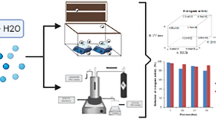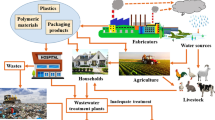Abstract
The presence of micropollutants in sewage is already widely known, as well as the effects caused by natural and synthetic hormones. Thus, it is necessary to apply treatments to remove them from water systems, such as advanced oxidation processes (AOPs) and membrane separation processes, which can oxidize and remove high concentrations of organic compounds. This work investigated the removal of 17β-estradiol (E2), 17α-ethinylestradiol (EE2), and estriol (E3) from biotreated sewage. Reverse osmosis processes were conducted at three recoveries (50, 60, and 70 %). For E2 and EE2, the removals were affected by the recovery. The best results for RO were as follows: the E2 compound removal was 89 % for 60 % recovery and the EE2 compound removal was 57 % for 50 % recovery. The RO recovery did not impact the E3 removal. It was concluded that the interaction between the evaluated estrogens, and the membrane was the major factor for the hormone separation. The AOP treatment using H2O2/UV was carried out in two sampling campaigns. First, we evaluated the variation of UV doses (24.48, 73.44, 122.4, and 244.8 kJ m−2) with 18.8 mg L−1 of H2O2 in the reaction. EE2 showed considerable removals (around 70 %). In order to optimize the results, an experimental design was applied. The best result was obtained with higher UV dose (122.4 kJ m−2) and lower H2O2 concentration (4 mg L−1), achieving removal of 91 % for E3 and 100 % for E2 and EE2.









Similar content being viewed by others
References
APHA, AWWA, WEF (2012) Standard methods for the examination of water and wastewater. 22 ed. Washington, DC
Belgiorno V, Rizzo L, Fatta D, Rocca CD, Lofrano G, Nikolaou A, Naddeo V, Meric S (2007) Review on endocrine disrupting-emerging compounds in urban wastewater: occurrence and removal by photocatalysis and ultrasonic irradiation for wastewater reuse. Desal 215:166–176. doi:10.1016/j.desal.2006.10.035
Bhandari RK, Deem SL, Holliday DK, Jandegian CM, Kassotis CD, Nagel SC, Tillit DE, Saal FS, Rosenfeld CS (2015) Effects of the environmental estrogenic contaminants bisphenol A and 17a-ethinyl estradiol on sexual development and adult behaviors in aquatic wildlife species. Gen Comp Endocr 214:195–219. doi:10.1016/j.ygcen.2014.09.014
Cartagena P, Kaddouri M, Cases V, Trapote A, Prats D (2013) Reduction of emerging micropollutants, organic matter, nutrients and salinity from real wastewater by combined MBR–NF/RO treatment. Sep Purif Technol 110:132–143. doi:10.1016/j.seppur.2013.03.024
Clara M, Kreuzinger N, Strenn B, Gans O, Kroiss H (2005) The solids retention time—a suitable design parameter to evaluate the capacity of wastewater treatment plants to remove micropollutants. Water Res 39:97–106. doi:10.1016/j.watres.2004.08.036
Comerton AM, Andrews RC, Bagley DM, Yang P (2007) Membrane adsorption of endocrine disrupting compounds and pharmaceutically active compounds. J Membrane Sci 303:267–277. doi:10.1016/j.memsci.2007.07.025
De la Cruz N, Giménez J, Esplugas S, Grandjean D, Alencastro LF, Pulgarín C (2012) Degradation of 32 emergent contaminants by UV and neutral photo-Fenton in domestic wastewater effluent previously treated by activated sludge. Water Res 46:1947–1957
Dias ACV, Gomes FW, Bila DM, Sant'Anna GL Jr, Dezotti M (2015) Analysis of estrogenic activity in environmental waters in Rio de Janeiro state (Brazil) using the yeast estrogen screen. Ecotox Environ Safe 120:41–47. doi:10.1016/j.ecoenv.2015.05.013
Garcia N, Moreno J, Cartmell E, Rodriguez-Roda I, Judd S (2014) The application of microfiltration-reverse-osmosis/nanofiltration to trace organics removal for municipal wastewater reuse. Environ Technol 34:3183–3189. doi:10.1080/09593330.2013.808244
Gerrity D, Gamage S, Holady JC, Mawhinney DB, Quiñones O, Trenholm RA, Snyder SA (2011) Pilot-scale evaluation of ozone and biological activated carbon for trace organic contaminant mitigation and disinfection. Water Res 45:2155–2165. doi:10.1016/j.watres.2010.12.031
Hai FI, Nguyen LN, Nghiem LD, Liao B, Koyuncu I, Price WE (2014) Trace organic contaminants removal by combined processes for wastewater reuse. Env Chem 318. doi:10.1007/698_2014_318
Hamid H, Eskicioglu C (2012) Fate of estrogenic hormones in wastewater and sludge treatment: a review of properties and analytical detection techniques in sludge matrix. Water Res 46:5813–5833. doi:10.1016/j.watres.2012.08.002
Harbert AC, Borges CP, Nobrega R (2006) Membrane separation process. Rio de Janeiro, BR:E-papers. In: Portuguese
Heo J, Boateng LK, Flora JRV, Lee H, Her N, Park Y, Yoon Y (2013) Comparison of flux behavior and synthetic organic compound removal by forward osmosis and reverse osmosis membranes. J Membrane Sci 443:69–82. doi:10.1016/j.memsci.2013.04.063
Hu X, Shi W, Cao F, Hu G, Hao Y, Wei S, Wang X, Yu H (2013) Bioanalytical and instrumental analysis of estrogenic activities in drinking water sources from Yangtze River Delta. Chemosphere 90:2123–2128. doi:10.1016/j.chemosphere.2012.10.095
INMETRO (2010) Orientation about analytical methody validation, overal coordination o accreditation. In: Portuguese. DOQ-CGCRE-008
James CP, Germain E, Judd S (2014) Micropollutant removal by advanced oxidation of microfiltered secondary effluent for water reuse. Sep Purif Technol 127:77–83. doi:10.1016/j.seppur.2014.02.016
Kimura K, Toshima S, Amy G, Watanabe Y (2004) Rejection of neutral endocrine disrupting compounds (EDCs) and pharmaceutical active compounds (PhACs) by RO membranes. J Membrane Sci 245:71–78. doi:10.1016/j.memsci.2004.07.018
Lee Y, Kovalova L, McArdell CS, Gunten U (2014) Prediction of micropollutant elimination during ozonation of a hospital wastewater effluent. Water Res 64:134–148. doi:10.1016/j.eatres.2014.06.027
Linares RV, Yangali-Quintanilla V, Li Z, Amy G (2011) Rejection of micropollutants by clean and fouled forward osmosis membrane. Water Res 45:6737–6744. doi:10.1016/j.watres.2011.10.037
Liu P, Zhang H, Feng Y, Yang F, Zhang J (2014) Removal of trace antibiotics from wastewater: a systematic study of nanofiltration combined with ozone-based advanced oxidation processes. Chem Eng J240:211–220. doi:10.1016/j.cej.2013.11.057
Liu Z, Kanjo Y, Mizutani S (2009) Removal mechanisms for endocrine disrupting compounds (EDCs) in wastewater treatment biodegradation, and chemical advanced oxidation: a review. Sci Total Environ 407:731–748. doi:10.1016/j.scitotenv.2008.08.039
Luo Y, Guo W, Ngo HH, Nghiem LD, Hai FI, Zhang J, Liang S, Wang XC (2014) A review on the occurrence of micropollutants in the aquatic environment and their fate and removal during wastewater treatment. Sci Total Environ 473-474:619–641. doi:10.1016/j.scitontenv.2013.12.065
Manickum T, John W (2014) Occurrence, fate and environmental risk assessment of endocrine disrupting compounds at the wastewater treatment works in Pietermaritzburg (South Africa). Sci Total Environ 468-469:584–597. doi:10.1016/j.scitotenv.2013.08.041
Nghiem LD, Manis A, Soldenhoff K, Schäfer AI (2004) Estrogenic hormone removal from wastewater using NF/RO membranes. J Membrane Sci 242:37–45. doi:10.1016/j.memsci.2003.12.034
Nogueira RF, Oliveira MC, Paterlini WC (2005) Simple and fast spectrophotometric determination of H2O2 in photofenton reactions using matavanadate. Talanta 66:86–91. doi:10.1016/j.talanta.2004.10.001
Richard J, Boergers A, Eyser C, Bester K, Tuerk J (2014) Toxicity of the micropollutants bisphenol A, ciprofloxacin, metoprolol and sulfamethoxazole in water samples before and after the oxidative treatment. Int J Hyg Envir Heal 217:506–514. doi:10.1016/j.ijheh.2013.09.007
Roberts J, Kumar A, Du J, Hepplewhite C, Ellis DJ, Christy AG, Beavis SG (2016) Pharmaceuticals and personal care products (PPCPs) in Australia’s largest inland sewage treatment plant, and its contribution to a major Australia river during high and low flow. Sci Total Environ 541:1625–1637. doi:10.1016/j.scitotenv.2015.03.145
Rodriguez-Mozaz S, Ricart M, Köck-Schulmeyer M, Guasch H, Bonnineau C, Proia L, Alda ML, Sabater S, Barceló D (2015) Pharmaceuticals and pesticides in reclaimed water: efficiency assessment of a microfiltration–reverse osmosis (MF–RO) pilot plant. J Hazard Mater 282:165–173. doi:10.1016/j.jhazmat.2014.09.015
Routledge EJ, Sumpter JP (1996) Estrogenic activity of surfactants and some of their degradation products assessed using a recombinant yeast screen. Environ Toxicol Chem 15(3):241–248
Sadmani AHMA, Andrews RC, Bagley DM (2014) Influence of naturally occurring dissolved organic matter, colloids, and cations on nanofiltration of pharmaceutically active and endocrine disrupting compounds. Chemosphere 117:170–177. doi:10.1016/j.jwpe.2014.05.004
Schäfer AI, Akanyeti I, Semião AJ (2011) Micropollutant sorption to membrane polymers: a review of mechanisms for estrogens. Adv Colloid Interfac 164:100–117. doi:10.1016/j.cis.2010.09.006
Servos MR, Bennie DT, Burnison BK, Jurkovic A, McInnis R, Neheli T, Schnell A, Seto P, Smyth SA, Ternes TA (2005) Distribution of estrogens, 17b-estradiol and estrone, in Canadian municipal wastewater treatment plants. Sci Total Environ 336:155–170. doi:10.1016/j.scitotenv.2004.05.025
Shanmuganathan S, Johir MA, Nguyen TV, Kandasamy J, Vigneswaran S (2015) Experimental evaluation of microfiltration granular activated carbon (MF GAC)/nano filter hybrid system in high quality water reuse. J Membrane Sci 476:1–9. doi:10.1016/j.memsci.2014.11.009
Shu Z, Bolton JR, Belosevic M, Din MG (2013) Photodegradation of emerging micropollutants using the medium-pressure UV/H2O2 advanced oxidation process. Water Res 47:2881–2889. doi:10.1016/j.watres.2013.02.045
Silva LLS (2016) Usage of UV/H2O2 and reverse osmosis to remove estrogens present in biotreated sewage. Dissertation, Federal University of Rio de Janeiro. In: Portuguese
Sui Q, Huang J, Deng S, Yu G, Fan Q (2010) Occurrence and removal pharmaceuticals, caffeine and DEET in wastewater treatment plants of Beijing, China. Water Res 44:417–426. doi:10.1016/j.watres.2009.07.010
Williams ME, Hesteki JA, Smothers CN, Bhattacharyya D (1999) Separation of organic pollutants by reverse osmosis and nanofiltration membranes: mathematical models and experimental verification. Ind Eng Chem Res 38:3683–3695. doi:10.1021/ie990140l
Yan C, Nie M, Yang Y, Zhou J, Liu M, Baalousha M, Lead JR (2015) Effect of colloids on the occurrence, distribution and photolysis of emerging organic contaminants in wastewaters. J Hazard Mater 299:241–248. doi:10.1016/j.jhazmat.2015.06.022
Yangali-Quintanilla V, Maeng SK, Fujioka T, Kennedy M, Amy G (2010) Proposing nanofiltration as acceptable barrier for organic contaminants in water reuse. J Membrane Sci 362:334–345. doi:10.1016/j.memsci.2010.06.058
Zhang A, Li Y (2014) Removal of phenolic endocrine disrupting compounds from waste activated sludge using UV, H2O2 and UV/H2O2 oxidation processes: effects of reaction conditions and sludge matrix. Sci Total Environ 493:307–323. doi:10.1016/j.scitotenv.2014.05.149
Acknowledgment
The authors want to thank FAPERJ and CAPES for research founding, which made this project possible.
Author information
Authors and Affiliations
Corresponding author
Additional information
Responsible editor: Philippe Garrigues
Rights and permissions
About this article
Cite this article
Silva, L.L.S., Sales, J.C.S., Campos, J.C. et al. Advanced oxidative processes and membrane separation for micropollutant removal from biotreated domestic wastewater. Environ Sci Pollut Res 24, 6329–6338 (2017). https://doi.org/10.1007/s11356-016-7312-y
Received:
Accepted:
Published:
Issue Date:
DOI: https://doi.org/10.1007/s11356-016-7312-y




